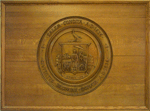Peabody Essex Museum: Difference between revisions
No edit summary |
No edit summary |
||
| Line 12: | Line 12: | ||
With their physical proximity, closely connected boards and overlapping collections, the possibility of consolidating the Essex and the Peabody had been discussed over the years. After in-depth studies showed the benefits of such a merger, the consolidation of these two organizations into the new PEM was effected in July 1992. The museum possessed more than 840,000 works of art and culture featuring maritime art and history; American art; Asian, Oceanic, and African art; Asian export art; two large libraries with over 400,000 books, manuscripts, and documents; and 22 historic buildings. Today’s collection has grown to include approximately 1 million works and Yin Yu Tang, the only complete Qing Dynasty house outside China" according to the PEM's website. | With their physical proximity, closely connected boards and overlapping collections, the possibility of consolidating the Essex and the Peabody had been discussed over the years. After in-depth studies showed the benefits of such a merger, the consolidation of these two organizations into the new PEM was effected in July 1992. The museum possessed more than 840,000 works of art and culture featuring maritime art and history; American art; Asian, Oceanic, and African art; Asian export art; two large libraries with over 400,000 books, manuscripts, and documents; and 22 historic buildings. Today’s collection has grown to include approximately 1 million works and Yin Yu Tang, the only complete Qing Dynasty house outside China" according to the PEM's website. | ||
[[Category:Browse Index]] | [[Category:Browse Index]] | ||
Revision as of 10:01, 18 March 2011
Taken from the Peabody Essex Museum Website
"The roots of the Peabody Essex Museum date to the 1799 founding of the East India Marine Society, an organization of Salem captains and supercargoes who had sailed beyond either the Cape of Good Hope or Cape Horn. The society’s charter included a provision for the establishment of a “cabinet of natural and artificial curiosities,” which is what we today would call a museum. Society members brought to Salem a diverse collection of objects from the northwest coast of America, Asia, Africa, Oceania, India and elsewhere. By 1825, the society moved into its own building, East India Marine Hall, which today contains the original display cases and some of the very first objects collected" according to PEM's website.
Origins of the Name
"The East India Marine Society was founded in Salem, in Essex County, Massachusetts. Salem was also home to the Essex Historical Society (founded in 1821), which celebrated the area’s rich community history, and the Essex County Natural History Society (founded in 1833), which focused on the county’s natural wonders. In 1848, these two organizations merged to form the Essex Institute (the “Essex” in the Peabody Essex Museum’s name). This consolidation brought together extensive and far-ranging collections, including natural specimens, ethnological objects, books and historical memorabilia, all focusing on the area in and around Essex County.
In the late 1860s, the Essex Institute refined its mission to the collection and presentation of regional art, history and architecture. In so doing, it transferred its natural history and archaeology collections to the East India Marine Society’s descendent organization, the Peabody Academy of Science (the “Peabody”). In turn, the Peabody, renamed for its great benefactor, the philanthropist George Peabody, transferred its historical collections to the Essex.
In the early 20th century, the Peabody Academy of Science changed its name to the Peabody Museum of Salem and continued to focus on collecting international art and culture. Capitalizing on growing interest in early American architecture and historic preservation, the Essex Institute acquired many important historic houses and made them fit for historical interpretation.
With their physical proximity, closely connected boards and overlapping collections, the possibility of consolidating the Essex and the Peabody had been discussed over the years. After in-depth studies showed the benefits of such a merger, the consolidation of these two organizations into the new PEM was effected in July 1992. The museum possessed more than 840,000 works of art and culture featuring maritime art and history; American art; Asian, Oceanic, and African art; Asian export art; two large libraries with over 400,000 books, manuscripts, and documents; and 22 historic buildings. Today’s collection has grown to include approximately 1 million works and Yin Yu Tang, the only complete Qing Dynasty house outside China" according to the PEM's website.
See Also
- PEM PEM Official Website
- East India Marine Society and the Peabody Museum of Salem W.M. Whitehill, 1949.
- Sketch of Salem By C.S. Osgood, p. 110-115
- East India Marine Hall Salem Tales, SalemWeb.com
